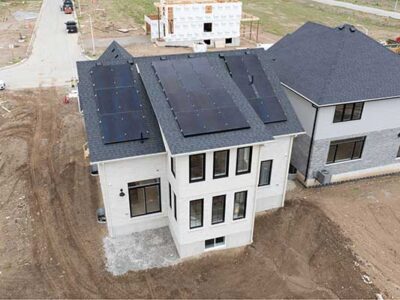- Legislative support for large-scale solar projects in New York has increased farmland prices by 15–22% near energy infrastructure, reflecting the land's potential for solar development.
- This benefits landowners but may hinder agricultural use, reduce food security, and limit access for new farmers.
- Price effects are strongest near substations and in regions with higher electricity prices.
A new Cornell study finds that the legislative support for solar projects in New York state has boosted the price of farmland, with positive and negative effects for various stakeholders.
In the study, published in SSRN Electronic Journal, researchers find that after New York state passed legislation supporting large-scale community solar farms in 2015, the price of farmland within two miles of energy infrastructure rose 15% to 18% compared to parcels farther away, as the market reflected the potential of those lots for solar development. The increased prices could disincentivize the use of the lots for farming.
“Landowners could see the higher prices as a positive, but there may be cascading negative effects on tenants and communities,” said co-author Wendong Zhang, associate professor in the Charles H. Dyson School of Applied Economics and Management in the Cornell SC Johnson College of Business. “It’s important to think about balancing the development to achieve the state’s energy and emissions reduction goals with potential impacts of the loss of agricultural land to solar.”
Agricultural land can be ideal for solar farms, especially when located in proximity to substations or transmission lines; and developers could offer farmers lucrative leases and steady paychecks that don’t rely on fickle weather or crops. But the loss of agricultural lands could hurt renters and farm workers, as well as reduce food security and agricultural productivity in the state, the authors write. The increased prices might also make it harder for new farmers to break into the market.
“More expensive farmland is bad news if you are trying to buy land for agricultural purposes, but good news if you are the seller,” said co-author Ariel Ortiz-Bobea, associate professor in the Dyson School in Cornell SC Johnson. “But this additional pressure on farmland markets is very concentrated around existing electricity infrastructure.”
“The effect is also more pronounced during the policy stage, when the economic incentives for development become clearer,” said first author Zhiyun Li, Ph.D. ’23, now an economist at the University of California, Los Angeles Anderson Forecast.
Previous research had looked at farmland values adjacent to existing solar farms. But the team wanted to capture the impact on land values of the larger regulatory and market forces that are essential for accelerating solar development. They analyzed nearly 12,000 transactions in New York state between 2007 and 2021, finding prices increased after the passage of the Shared Renewable Program in 2015—which paved the way for residents to buy energy credits from solar farms—and subsequent policies to support the development of large-scale solar.
“We argue that an increase in land value is not necessarily about whether you have a solar farm nearby. What matters is whether you are in the corridor for transmission lines or within areas very close to electricity substations,” Zhang said. “And then the policy enables development: It sends a signal to the market participants that the location of that land has value.”
The team also found that the land values increased more in regions with higher electricity prices: The cost of farm parcels near substations increased by 20% to 22%—an indication that a higher demand for solar energy in a given region may push land prices up further.
The research points to an unintended consequence of policies like the Shared Renewable Program and supporting legislation. With the current fast-tracking of many more large-scale solar farms in New York, Zhang said the questions the study raises may become more pressing, and the cost of farmland adjacent to infrastructure may see greater price hikes.
“A lot of the currently proposed sites in New York are 25 megawatts or more, some are even 100 megawatts, which would represent more than 500 acres,” he said. “So this is an issue that has growing impact and significance.”
Zhang serves on a committee for the New York State Energy Research and Development Authority that aims to understand and report on the impacts of solar development on agriculture. He and collaborators are working to assess how agriculture and solar can dovetail, such as by growing crops alongside or under solar panels, for example.
One of the earliest adopters, New York state became the largest community solar market in the U.S. by 2021, and the authors said the lessons from the rollout can be useful for other regions.
“As our energy system transitions toward renewables, states can proactively design policies to manage the unintended consequences emerging from rapid renewable deployment and legacy infrastructure,” Ortiz-Bobea said.
“State policy is probably the most important driver of solar placement, so this provides an understanding of the impacts for policymakers,” Zhang said. “Next, we want to look at how these large-scale, solar-enabling legislations manifest in other regions and other states.”
Publication Referenced in the Article:
Zhiyun Li et al, The Impact of Large-scale Solar Development on Farmland Values: Evidence from New York State, SSRN Electronic Journal (2024). DOI: 10.2139/ssrn.4942012
This article has been adapted from source material published by Cornell University.












Comments